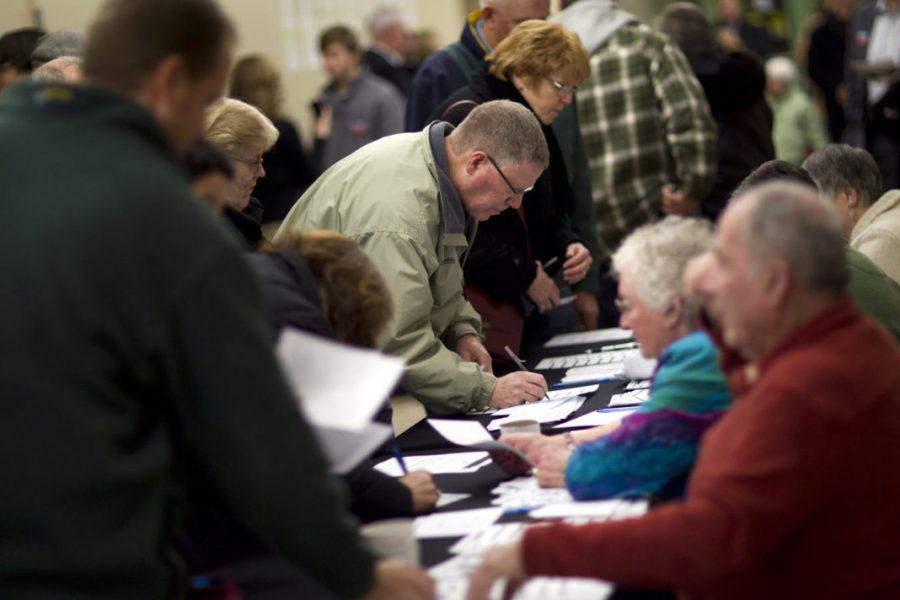Zhu: Technology is the answer to the question nobody asked in the Iowa caucuses
FILE – In this Jan. 3, 2012 file photo, voters sign in on caucus night at Point of Grace Church in Waukee, Iowa. More than 40 years ago, a scheduling quirk vaulted Iowa to the front of the presidential nominating process, and ever since most White House hopefuls have devoted enormous time and money to a state that otherwise would get little attention. (AP Photo/Evan Vucci, File)
The Iowa caucuses reflect not only a complicated political season, but also a major issue in the intersection of technology and other fields—what problems does technology solve, and what problems are created for technology to solve?
A few days after the caucuses, at least some of the blame has fallen onto the company, Shadow, responsible for creating the app that failed recorders. The app, contracted on behalf of the Iowa Democratic Party, was created to ease the process of recording and reporting results. More and more, it seems that we are so excited by the advent of new technology. From applications to cloud computing, companies and organizations are fitting square pegs into round holes by forcing technology to provide solutions for problems that already had adequate solutions. In short: If it ain’t broke, why do we insist on fixing it?
A major problem in applying technology to problems that do not need it is that almost everyone underestimates the amount of time necessary to even create a solution, particularly in creating applications for public use. In the case of the Iowa Democratic caucuses, it has generated a significant delay in the reporting of important information to the public, with major disagreements about numbers in a political race already shrouded in uncertainty. From the impeachment trial to questions about election tampering that linger from the previous presidential election, this is nowhere near the best time for an application failure to arise.
The issues that were reported to the public included issues with logging in and confusion about how to use the application. These are most often the major problems with creating applications for the public. There are costs associated with training and user understanding of an application that center around the user experience and user interfacing side of an application. These are issues that are often fixed or tweaked in testing, which is typically the first step sacrificed when developing an application under a time limit.
This is not the only place where we see functionality sacrificed in favor of a deadline. Consider the launch of the streaming platform Disney+. Even today, months after the launch of the product, users can clearly see bugs in the software, like repeated titles and confusing user interface. However, at least Disney+ is a response to a demand in industry, which is seen less often in products like applications to log delegate counts in a caucus.
In the tech industry in general, it has become a widely acknowledged joke that the startup culture and the need to generate something new and exciting has led entrepreneurs to solve problems that don’t exist. However, in Silicon Valley, entrepreneurs are limited by the free market and the demand for their product. In the case of handling digitally sensitive information, like voter information and delegate counts, it is entirely unethical to use technology if it has not been properly tested and evaluated to ensure that it performs its intended task.
Beyond the issue of functionality and usefulness, there have also been questions about connections between presidential candidate Pete Buttegieg’s campaign and the company, Shadow, that casts major doubt over the entire operation. Not only does his campaign donate to Shadow, but the husband of the CEO is a high-ranking member of Buttegieg’s campaign. Reports have since indicated these payments were for unrelated services, but it certainly still raises eyebrows.
Ultimately, we must seek security over efficiency in issues as serious as these caucuses leading up the presidential election. Although the caucus system itself is nowhere near perfect, older methods of logging and measuring voter turnout are much more reliable than a new, clearly untested, application. We must hold our government and voting system accountable for the inconsistencies in numbers, and ensure that they maintain a system we can trust in.

Caroline Zhu is a second-year computer science major with a deep and abiding love for Shakespeare. She spends most of her time arguing about the Oxford...


